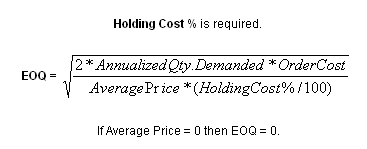Calculating economic order quantity (EOQ)
Calculate the EOQ for a store to determine the most efficient quantity to order for inventory items. EOQ represents the ideal balance between ordering costs and inventory holding costs for items being demanded annually at a constant rate. EOQ helps manage inventory by minimizing order costs and holding costs for each item.
To calculate EOQ:
- Select Materials > Process > Calculate EOQ.
-
Specify this information:
- Organization
- Specify the organization for which to calculate EOQ if you use multi-organization security.
- Date From
- Specify the date of the item’s first analysis.
- Date To
- Specify the date of the item’s last analysis.
- Store
- Specify the store for which to calculate EOQ.
- Part
- Specify the part for which to calculate EOQ.
- Stock Class
- Specify the class of the stock for which to calculate EOQ.
- ABC Class
- Select the class of the stock (A, B, or C) for which to calculate EOQ.
-
Choose one of these options:
Option Description % of Average Price Select to calculate EOQ with a percentage of average price. Skip step 11. Note: The system uses this equation to calculate EOQ based upon % of Average Price.Holding Cost % is required.
EOQ=

Fixed Value Select to calculate EOQ with a fixed value. Skip step 10. Note: The system uses this equation to calculate EOQ based upon Fixed Value.Holding Cost is required.
EOQ =

-
Specify the following:
- Holding Cost %
- Specify the cost for the holding percentage.
- Holding Cost
- Specify the holding cost.
- Fixed Order Cost
- Specify the fixed order cost.
- Print Calculated EOQ
- Select to print the EOQ report.
- Click Process.
- Select each store for which to update the order quantity.
- Click Update Order Qty. The system updates the order quantity on the Stores page of the Parts form for each selected parts record with the value in New Order Qty.